Pruning of the Blackcurrant and Currant bushes
• Why Prune ?
• Basic principles of pruning
• How to choose your pruning equipment
• When to prune ?
• Pruning shrubs
• Pruning hedges
• Fruit trees pruning
• Pruning shade trees
• Pruning trees
• Topiary art
• Pruning flowering plants
• Shape a pollarded tree
• Pruning of the Hydrangea Macrophylla
• Pruning of panicle producing Hydrangeas
• Pruning of the Lagerstroemia
• Pruning Roses
• Pruning Lavender
• Pruning of the Buddleia - Butterfly shrub
• Winter pruning of the climbers producing fruits
• Pruning of the Blackcurrant and Currant bushes
• Pruning of the Wisteria
Secateurs, Hedge Clippers, Hedge Trimmers, Saws, Pruning Loppers, Pruning Saws, Chainsaws...
These small fruiting bushes are easy going and need a good pruning with secateurs approximately once every two years to keep their vigour, or failing that, they get older and don't give as much fruits. Pruning is simple so do not hesitate!
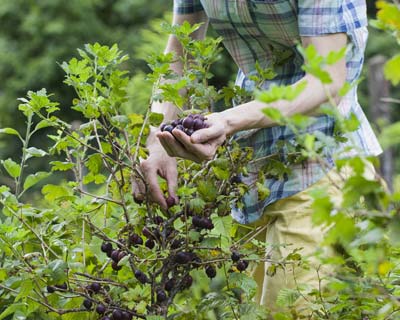
To carry on harvesting currants and blackcurrants, prune without failing.
Young stem rather than old wood
Blackcurrant and Currant bushes are shrubs. Therefore they do not form a main trunk but several stems growing from one point level with the ground. In order to keep these small fruiting shrubs healthy, you must encourage the formation of new stems. The biggest fruits and the heaviest bunch form on the younger stems which form last years. In pruning this year, you already work for next year's harvest!
When to prune
The ideal time to prune your Blackcurrant and Currant bushes is between November and February but it is possible to prune them a little bit before or after if they have not started producing and you have no other choice. It is also possible to prune them straight after the harvest but the result is not as good as when they are pruned in winter. On the weather side, Blackcurrants and Currant bushes can be pruned in all-weather although it is best not to prune them during a frosty period.
The right stage to start pruning them is when they get to 3 years at least. The oldest branches start to accumulate and you must think about their renewal.
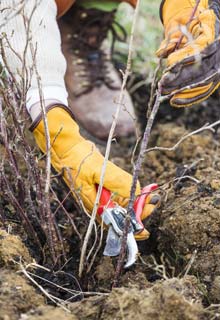
Remove the oldest branches.
The method
These shrubs need their older branches removed every year. This method gives the advantage of not causing a harvest-free year as new stems form each year. The only difficulty lies in spotting the oldest branches. Their bark is duller than the others, they are more ramified and often a bit of lichen is noticed. Cut them right back without however removing more than half of the stems on one clump.
Shorten approximately by a third last year's branches if they are very long and are bigger than the rest of the clump. Let the suckers which appear at the base grow during summer: they are your future harvests!
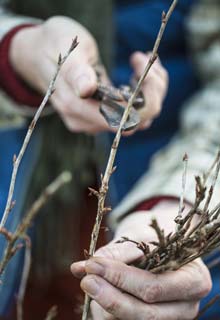
Shorten the stems which have grown too long.
A radical alternative
It consists of cutting right back the bush every 3 to 4 years so as to renew the entire branches. However it means a year with no harvest. Nevertheless this is a good solution to rejuvenate a specimen which has been left with no care during several years.
To each variety its pruning
Blackcurrant and Currant bushes have their own preferences but the principle remains identical for all.
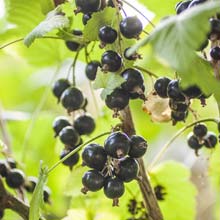
Blackcurrant bush
You can only prune it one year on three as they accumulate less old wood than Currant bushes. In the smallest gardens, let some branches grow high, even if it means only keeping 4 or 5 stems per bush so that they do not take up too much floor space.
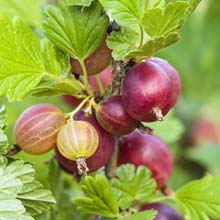
Gooseberry bush
Gooseberry bushes form few branches from the base but they are much more ramified. Each year do a light pruning intended to improve light's diffusion. Remove part of the branches growing towards the centre. Cut right back the small, twisted, not highly vigorous branches as they are not the ones which produce fruits.
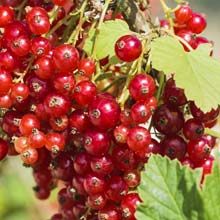
Currant bush
It has the same preferences than the Blackcurrant bush. Do a hard pruning on older stems so as to encourage the forming of new branches.
The lichen, a frequent, uninvited guest
It often appears on the branches of the Gooseberry bushes rather than on the Blackcurrant or Currant bushes' branches. It does not really cause any kind of problems. Contrary to belief, it is not lichen that reduces the specimen's vigour but the lack of pruning! Indeed, if lichen has time to cover up stems, it is because they have not been renewed over a long period of time. So pruning well Gooseberry bushes will make everything get back to normal, naturally!















































































































































































































































